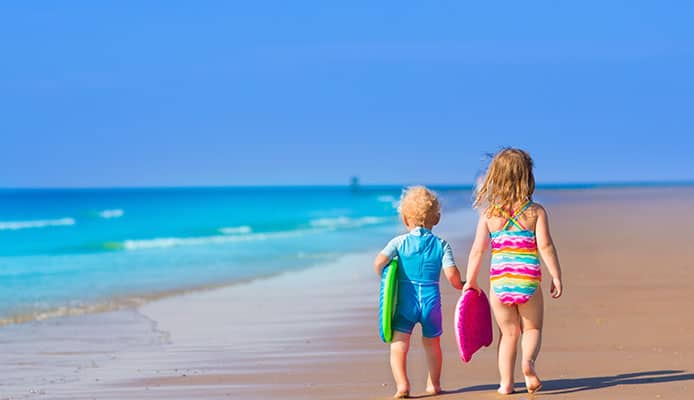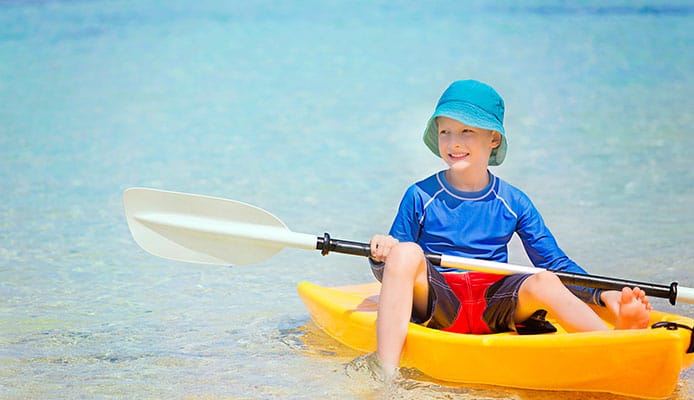
One of the first thoughts that crosses a parent’s mind is to protect their children from the sun during outdoor activities. Sunscreen is a great barrier for your child’s skin, but it needs to be frequently reapplied, especially if you’re at the pool or beach. A better way to protect a child’s skin when they’re having fun splashing in the pool or chasing the waves is to use children’s rash guards.
Child rash guards are pieces of sun protective clothing that create a barrier that stops the harmful rays of the sun from causing sunburns. They are durable, quick drying, lightweight, and breathable to ensure that your child is always comfortable when wearing it. But they protect from more than just the sun too. For beach days, swimming shirts for kids can protect against the sand, rashes, scrapes, and chaffing. Plus, they come in short and long sleeve designs, so you can choose the perfect level of protection that your kids need to have a fun filled day outdoors.
OUR TOP PICK
Kanu Surf Platinum Boy’s
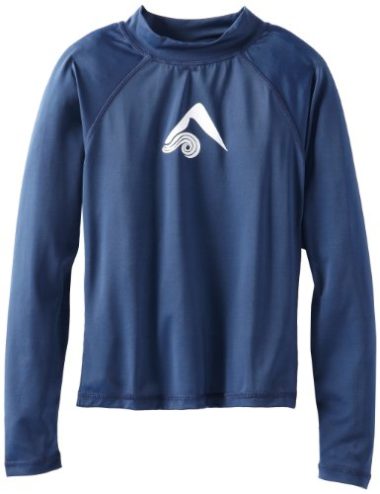
- Stand Out Features - Why We Love It
- Long sleeve design covers more of your kid’s skin, so less sunscreen needs to be reapplied
- Mock turtleneck provides coverage for sensitive skin
- Polyester and Spandex blend gives a strong UPF 50+ rating to stop the sun’s rays
- Quick drying and lightweight fabric is soft to the touch
- No skin irritation or rashes
- Looser fit is comfortable for a casual day at the beach
Product Dimensions: 1 x 1 x 1 inches
Weight: 1 pound
Sun Protection: UPF 50+
Quick Dry: Yes
Fit: Looser
Style: Long sleeve, mock turtleneck
Fabric: Polyester, Spandex
EDITORS CHOICE
Kanu Surf Boy’s Short Sleeve
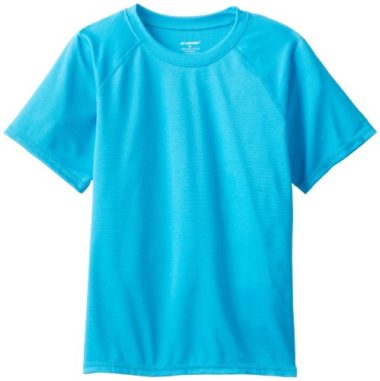
- Stand Out Features - Why We Love It
- Comfortable because the fit is looser than a traditional rash guard
- Freedom to move how they want without restriction
- Polyester fabric is durable and has a UPF 50+ rating to eliminate sun damage
- Pull-on closure is easy to put on and take off
- Moisture wicking to eliminate sweat and be quick drying
- Machine wash for easy maintenance
Sun Protection: UPF 50+
Quick Dry: Yes
Fit: Looser
Style: Short sleeve, crew neck
Fabric: Polyester
BEST VALUE
O’Neill Basic Skins Youth
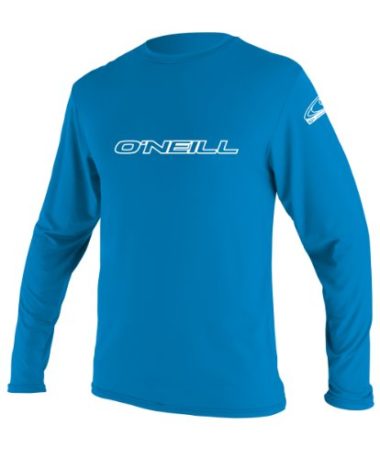
- Stand Out Features - Why We Love It
- Perfect for a variety of activities, which makes it versatile
- Polyester and Elastane fabric has a UPF 50+ rating to eliminate the risk of skin cancer
- Durable construction and minimal seam placement ensure there won’t be rashes or irritation
- Slim fit is snug to body, but won’t restrict movement
Product Dimensions: 9 x 5 x 1 inches
Weight: 2.08 ounces
Sun Protection: UPF 50+
Fit: Snug
Style: Long sleeve, crew neck
Fabric: Polyester, Elastane
Estamico Boy’s Long Sleeve
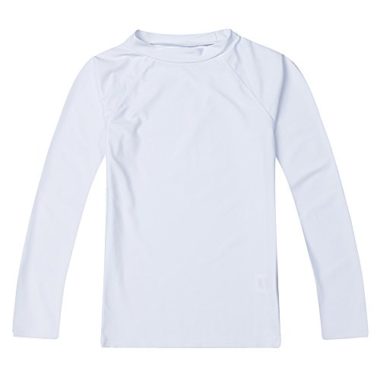
- Stand Out Features - Why We Love It
- Athletic Nylon and Spandex fabric offer a stretch built for movement
- Long sleeve design provides extra sun protection by covering exposed skin
- Slim fit to ensure it never gets in the way of movement
- UPF 50+ rating stops sunburns for worry-free play
Sun Protection: UPF 50+
Fit: Slim
Style: Long sleeve, crew neck
Fabric: Nylon, Spandex
Leveret Long Sleeve Toddler
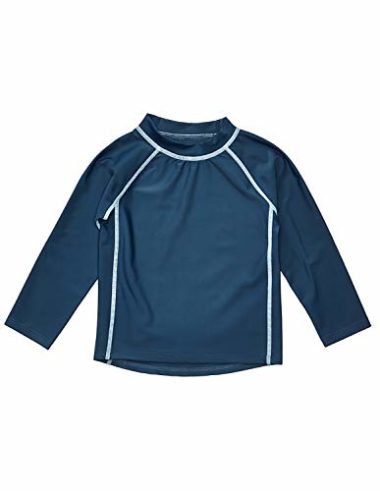
- Stand Out Features - Why We Love It
- Protect your child’s delicate skin will a full coverage long sleeve design
- Protection both in and out of the water
- UPF 50+ rating is reliable at stopping the sun
- Durable, comfortable, and simple without skin irritation
Product Dimensions: 4 x 3 x 0.5 inches
Weight: 3 pounds
Sun Protection: UPF 50+
Style: Long sleeve, crew neck
Fabric: Nylon, Elastane
City Threads Little Boys and Girls
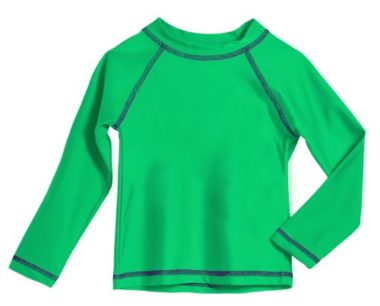
- Stand Out Features - Why We Love It
- Maximum sun protection with a UPF 50+ rating
- Silk smooth fabric is comfortable
- Durable and long-lasting, so your kids can move
- No dyes or harsh chemicals for sensitive skin
Sun Protection: UPF 50+
Style: Long sleeve, crew neck
Kanu Surf Haywire Kids
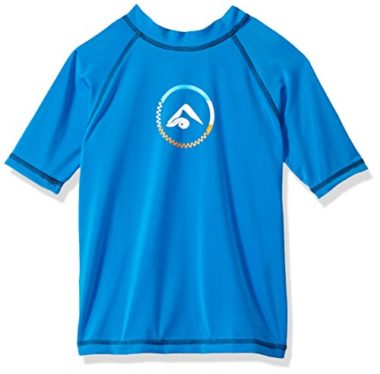
- Stand Out Features - Why We Love It
- Versatile design can fit the whole family
- UPF 50+ rating is great for swimming or relaxing at the beach
- Comfortable fit means no complaints
- Machine wash for easy care
- Quick dry means your kids will never be wet or cold
Sun Protection: UPF 50+
Style: Short sleeve, crew neck
Fabric: Polyester, Spandex
O’Neill Basic Skins Long Sleeve
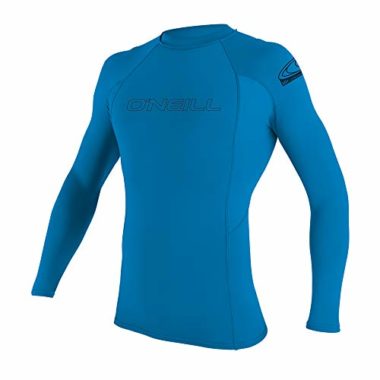
- Stand Out Features - Why We Love It
- Durable for thrilling activities like surfing
- Form fitting to act like a second skin
- UPF 50+ rating for long days outside
- Comfortable design has minimal seam placement
- No rashes or irritation
Weight: 1 pound
Sun Protection: UPF 50+
Style: Long sleeve, crew neck
Fabric: Polyester, Elastane
How To Choose A Kid’s Rash Guard – Buying Guide
Every parent knows the struggle of putting on sunscreen or the tantrums that can follow when you have to interrupt your kids to reapply another layer but using a rash guard can eliminate the stress of having to lather on the lotion. Plus, top rated rashguards for kids should be so comfortable that they’re practically forgotten they’re being worn.
Below are some features that are important to consider that will help you find the best rashguards for kids, so you can be worry-free and confident that your kids are protected when they’re at the pool or beach.
UV Protection
It may be hard to believe, but not all clothing offers UV protection from the sun. Yes, clothing is a barrier between the sun and skin, but depending on factors like the fabric of the shirt, the rays may be able to pass through the material and still come into contact with the skin. This is why UV protection is the most important feature for youth rash guards to have incorporated into the material because it will prevent any nasty sunburns.
For children’s rash guards, UV protection means that the sun’s rays won’t be able to penetrate or pass through the material of the shirt to ensure that they can’t harm your child’s skin. To find toddler UV swimwear, you should check the product information for an ultraviolet protection factor (UPF) rating. This rating can tell you how powerful the UV protection is in a shirt. The higher the number, the better protection it will offer.
However, if a UPF rating is not included, you can also look at the material or type of fabric to estimate the level of protection. In general, synthetic materials will have more protection than natural materials because their weave is more tightly woven, and they are denser. The color of a rash guard kids’ shirt can also heavily affect the level of UV protection that it offers. Darker colors, like navy, will absorb more of the ultraviolet rays versus light colors, like white. But vibrant colors like red or yellow can also be very affective at absorbing UV rays over pastel colors, which means your child can still wear their favorite color.
Comfort
Most adults know that kids can be very picky about their clothing, especially when it comes to how it feels on their body. Children’s rash guards should be comfortable, so your kids don’t try to constantly rip it off. This means that youth rash guards don’t have any irritating sleeves or product tags to rub or bother the skin. The material should be strong, but also soft and quick drying to ensure your kid isn’t stuck in soaking wet clothes all day long.
Another big part of child rash guards that can be the difference between giggles and a tantrum is the collar. Most kids want to feel free, so a restrictive collar can really dampen their mood. A low-cut neckline can be more comfortable for kids, but it also leaves more sensitive skin exposed, which mean you’ll need to apply sunscreen often. A turtleneck would provide more coverage for a child’s neck, but it may be too restrictive for just a day at the pool or beach. Its best to gauge your child and determine what they will best tolerate.
Durability
If anyone knows how important durability is, its parents because kids have seemingly endless energy to run around and play. So, to keep up with kids, a rash guard needs to be durable in its construction. The key areas of durability in child rash guards are the material of the shirt and the seams.
Top rated rashguards for kids should be made of a durable material that is tightly woven and dense, which provides the best UV protection. Synthetic materials like nylon or polyester are great options because they have the durability to be worn all day long and still be comfortable. Synthetic materials can also withstand the friction of areas that rub, like the armpits, without causing irritation or overheating.
For the seams, it is highly recommended that youth rash guards have flat seams instead of seams that are clasped together. When stitched properly, flat seams are extremely durable and more comfortable because they are not raised up like clasped seams can be. The two pieces of fabric can be strongly joined with thread and still have the flexibility to allow your kids unrestricted movement, which mean the rash guard has a better durability overall.
You might also like: Letsfit Bluetooth 5.0 Headphones
Ease of Maintenance
Playing in the sand and eating some snacks can mean that your kids get dirty. The first place they’ll probably wipe their hands is on their shirt, so having an easy maintenance rash guard can help put parents at ease. The best kids rashguards will be easily thrown into the washer with a load of laundry, so parents don’t have to worry about handwashing the piece. However, you shouldn’t put it through the dryer. Instead, let it air dry so that it is longer-lasting and keeps its color.
Fit
The fit of child rash guards will be mostly dependent on the activity that the child plans to participate in. This is because different fits can make it better for your kids to move freely or safely. For example, if you take your kids paddle boarding, they’ll need a rash guard that has a snug, but not too tight fit. This is because loose clothing can get in the way of your kid’s movement as they paddle, but something too tight would be extremely uncomfortable. On the other hand, if you’re spending a day at the beach or pool, looser swimming shirts for kids would be great to allow them to run and swim without being restricted.
The fit can also be different depending on the design of the rash guard kids shirt and whether it has short or long sleeves. Short sleeves offer a larger range of motion, but they leave more exposed skin, which in turn means you’ll have to keep lathering on reef safe sunscreens. Long sleeves are very popular because they can be super comfortable and eliminate the struggle of getting kids to put on sunscreen. It can also provide a little more warmth, if you kid wants to go for a swim in ocean or pool.
It can be hard to determine the best fit, but one great suggestion is to check kids rashguard reviews for tips on how a certain shirt will fit or if it even fits true to size.
Material
Youth rash guards are made of a variety of materials, but the most popular choice is a synthetic fabric like nylon, lycra, or polyester. Synthetic materials tend to offer the best UV protection and they’ve been designed to be ultra-comfortable, so you kid won’t complain about having to wear it at the beach. Natural materials like cotton may also be used, but keep in mind they may not have as much UV protection or be as durable as a synthetic alternative.
FAQs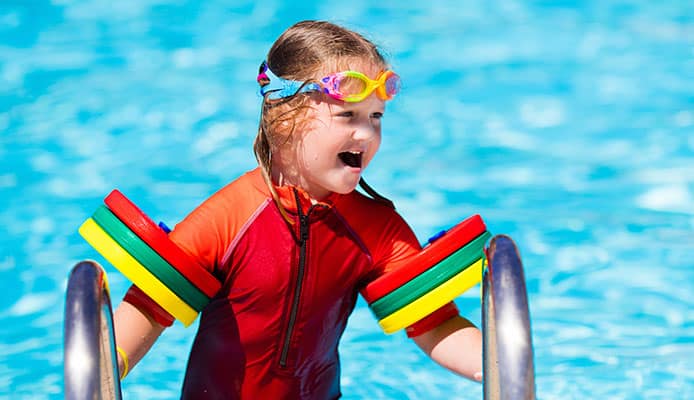
Q: Does a rash guard keep you warm?
Yes, a rash guard can keep you warm, but not as affectively as wetsuits. Rash guards are meant for light activities in the water, where you won’t be going to deep depths. For kids, scuba diving isn’t really a safe activity, so a rash guard will offer the perfect amount of warmth for paddle boarding, surfing, a day at the beach, or the pool. A long sleeve rash guard would also add more warmth than a short sleeve design.
Q: Should I get the long or short sleeve version?
This will depend on the activity your child wants to participate in and where you’ll be, as well as the level of sun protection you need. For activities like going to the pool or spending a day at the beach, a short sleeve child’s rash guard may be exactly what you need. Short sleeves offer more movement and are comfortable, but you do sacrifice less skin coverage. Long sleeves are great if your child doesn’t like sunscreen or needs another layer of warmth if they’ll be spending more time in the water. It’ll be up to the parents to decide what’s best for their child.
Q: Can a rash guard be used for non-water activities like running or hiking?
Yes! If you want to take your kids hiking or running or cycling, a rash guard can be a great shirt to wear because it has sweat wicking properties, is quick drying, lightweight and durable. You don’t have to use a rash guard just around water activities, which makes it a great versatile piece of clothing to invest in for your kids!
Globo Surf Overview
Understanding kids’ safety swimwear is what parents excel at because they understand how harmful the sun can be in both short term and long-term periods. For their kids, parent want the best and a great way to shield them from the sun is to use children’s rash guards. Youth rash guards are durable, lightweight, and effective at preventing sunburns. They can be used both in and out of the water, which means they’ll quickly become a versatile piece of your child’s wardrobe.


